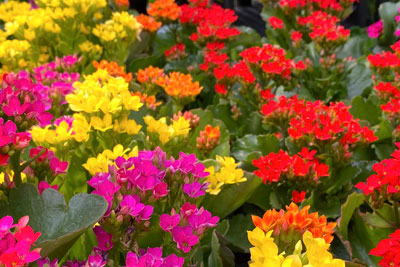Kalanchoes Kalling Your Name
I’ve had this photo in my files for three months and I couldn’t wait to use it.

(It reminds me of my 5th birthday. Mom had given me 75 cents for my present. We were at the Laundromat in College Station. I went next door to the candy store, and 10 minutes later young Neil proudly came back with 75 peanut butter logs to show his mom. 1 minute later young Neil was asking for a refund.)
I’ve decided this is as good a time as any to tell you why I love this plant.
First of all, I love succulents. They’re plants that have adjusted to austere conditions, usually drought, and figured a way to survive and even thrive.
Out of that huge group of plant families, genera and species that we know as “succulents,” the kalanchoes are some of the prettiest. And out of the kalanchoes, this one in particular has been bred to bloom gorgeously and predictably atop its glossy dark green foliage.
It can easily be grown as a florist crop, and it responds to night length to determine when it will come into bloom.

So you can see what others have written about it, I’m just going to copy and paste from a couple of other websites. This should be fun.
Kalanchoe konsiderations:
What others have said about this great little plant flowering tropical plant…
Missouri Botanical Gardens:
• “Their bloom time is incredibly long for a houseplant. Their bright red, pink or yellow flower clusters last for weeks.”
• Kalanchoe blossfeldiana
“Genus name comes from the corrupted and unintelligible Chinese name of one species of these succulent herbs or sub-shrubs.”
“Specific epithet honors German nurseryman Robert Blossfeld (1882-1945) active at Potsdam, Germany 1920-1940.”
• “New plantlets may occasionally appear at leaf margins and may be removed and potted up individually.”
(Note: It’s not uncommon for other kalanchoes to be propagated by laying leaves atop flats filled with well-draining potting soil.)
• “Flowering occurs within four months after exposure to six weeks of 14-hour nights. Ideal temperatures at this time are 60°F at night and 70°F during the day. Too low or too high temperatures may inhibit flowering.”
(Note: This means that this type of kalanchoe must have long nights that are not interrupted by light – just like chrysanthemums and poinsettias – to set flowerbuds.)
Clemson University:
https://hgic.clemson.edu/factsheet/kalanchoe/
How to pronounce “kalanchoe” (You’ll actually get to hear it said two different ways – neither of them the way that I say it!)
